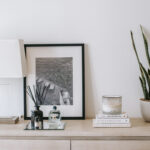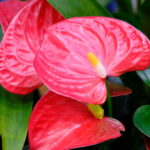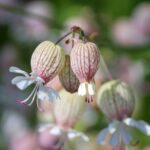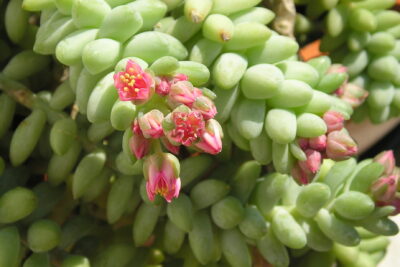
Guide to Rare Pink Succulents with Butterfly-Shaped Leaves

Succulents are a popular choice for plant lovers due to their unique shapes, low maintenance needs, and ability to thrive in various climates. Among the vast variety of succulents, there is a particular group that stands out - rare pink succulents with butterfly-shaped leaves. These stunning plants have gained a lot of attention in recent years, captivating gardeners and collectors alike with their vibrant colors and distinctive foliage.
We will delve into the fascinating world of rare pink succulents with butterfly-shaped leaves. We will explore the different types of these plants, their characteristics, and the ideal growing conditions for them. Additionally, we will provide tips and techniques for propagation and care, ensuring that you can successfully cultivate and enjoy these unique plants in your own garden or indoor space. Whether you are a seasoned succulent enthusiast or a beginner, this guide will provide you with valuable insights and knowledge to help you appreciate and grow these extraordinary plants.
- Research different species of succulents with butterfly-shaped leaves
- Visit local plant nurseries or succulent specialty stores to find rare pink succulents
- Connect with other succulent enthusiasts through online forums or social media groups to ask for recommendations
- Consider growing succulents from seeds or cuttings to increase your chances of finding rare pink varieties
- Create a suitable growing environment for your succulents, including providing proper lighting, temperature, and watering conditions
- Propagate your rare pink succulents to expand your collection
- Use well-draining soil and pots with drainage holes to prevent root rot
- Experiment with different fertilizers and techniques to enhance the pink coloration of your succulents' leaves
- Monitor your succulents for pests or diseases and take appropriate measures to prevent or treat them
- Share your knowledge and experiences with other succulent lovers by writing a blog or creating social media posts
- Enjoy the beauty and uniqueness of your rare pink succulents with butterfly-shaped leaves
- Frequently Asked Questions
- 1. Where can I find rare pink succulents with butterfly-shaped leaves?
- 2. How do I take care of rare pink succulents with butterfly-shaped leaves?
- 3. Can rare pink succulents with butterfly-shaped leaves survive in colder climates?
- 4. Do rare pink succulents with butterfly-shaped leaves propagate easily?
Research different species of succulents with butterfly-shaped leaves
When it comes to unique and eye-catching succulents, few can rival the rare pink varieties with butterfly-shaped leaves. These stunning plants are a favorite among succulent enthusiasts and collectors due to their distinct appearance and vibrant colors. If you're looking to add some charm and beauty to your succulent collection, this guide will introduce you to different species of pink succulents with butterfly-shaped leaves.
1. Pink Echeveria 'Perle von Nurnberg'
The Pink Echeveria 'Perle von Nurnberg' is a popular choice for succulent lovers. Its rosette-shaped leaves have a soft pink hue with hints of purple, giving them an enchanting appearance. The leaves' edges are adorned with delicate frills, resembling the wings of a butterfly. This succulent is relatively easy to care for and can thrive both indoors and outdoors.
2. Pink Kalanchoe 'Flapjack'
The Pink Kalanchoe 'Flapjack' is another mesmerizing succulent with butterfly-shaped leaves. Its leaves are thick and fleshy, resembling chubby butterfly wings. The leaves' color is a beautiful mix of pink and green, adding a unique touch to any succulent arrangement. This variety is known for its ability to change its leaf color depending on the amount of sunlight it receives.
3. Pink Sedum 'Little Missy'
The Pink Sedum 'Little Missy' is a petite succulent with leaves that resemble miniature butterfly wings. The leaves have a soft pink hue, often with hints of yellow or green. This succulent has a trailing habit, making it a perfect choice for hanging baskets or cascading arrangements. 'Little Missy' is a drought-tolerant plant, making it an excellent choice for those who tend to forget watering their succulents.
4. Pink Graptopetalum 'Ghost Plant'
The Pink Graptopetalum 'Ghost Plant' is a striking succulent with butterfly-shaped leaves that have a ghostly pinkish-gray appearance. Its leaves are thick and fleshy, forming beautiful rosettes. This variety is a wonderful addition to any succulent garden or container arrangement, as its unique coloring adds an element of intrigue and mystery.
 Rare Succulent Collection: Unique Cacti & Pineapple Varieties
Rare Succulent Collection: Unique Cacti & Pineapple Varieties5. Pink Aeonium 'Kiwi'
The Pink Aeonium 'Kiwi' is a show-stopping succulent with variegated leaves resembling butterfly wings. Its leaves have a captivating blend of pink, green, and creamy white, creating a visually stunning display. This succulent is a bit more demanding when it comes to care, preferring indirect sunlight and well-draining soil. With proper attention, the 'Kiwi' will reward you with its breathtaking beauty.
Adding these rare pink succulents with butterfly-shaped leaves to your collection will undoubtedly bring a touch of whimsy and elegance to your space. Remember to provide them with the right growing conditions, such as well-draining soil and appropriate sunlight levels, to ensure their healthy growth. Happy succulent gardening!
Visit local plant nurseries or succulent specialty stores to find rare pink succulents
If you're an avid succulent lover or simply looking to add a pop of color to your plant collection, rare pink succulents with butterfly-shaped leaves are an absolute must-have. These unique and eye-catching plants are sure to make a statement in any garden or indoor space. To get your hands on these rare beauties, consider visiting local plant nurseries or succulent specialty stores.
Plant nurseries are a great place to start your search for rare pink succulents. They often have a wide variety of plants, including some of the more elusive species. Take the time to explore different nurseries in your area and inquire about their collection of pink succulents. You might be pleasantly surprised by the range of options available.
If you're lucky, you might stumble upon a succulent specialty store. These stores are dedicated to all things succulent-related and tend to have a more extensive selection of rare and unique varieties. With their expertise and passion for succulents, the staff at these stores can offer valuable guidance and advice on caring for your new pink succulents.
When visiting a plant nursery or succulent specialty store, it's a good idea to have a specific list of pink succulents you're interested in. This will help you stay focused and ensure that you don't miss out on any must-have specimens. Some popular pink succulents with butterfly-shaped leaves include Echeveria 'Perle von Nürnberg', Graptosedum 'California Sunset', and Sedum 'Pink Jelly Bean'.
While exploring these stores, keep an eye out for signs or labels indicating the rarity of certain plants. Rare pink succulents are often highly sought after and may be priced accordingly. Don't be discouraged if you find that some varieties are more expensive than others. Remember, the uniqueness and beauty of these plants make them well worth the investment.
 Discover the Stunning Flowering Succulents that Transform Gardens
Discover the Stunning Flowering Succulents that Transform GardensOnce you've found your perfect rare pink succulents, be sure to ask the staff about their care requirements. Each species may have specific needs when it comes to sunlight, water, and soil conditions. By understanding and meeting these requirements, you can ensure that your pink succulents thrive and continue to dazzle with their stunning butterfly-shaped leaves.
Visiting local plant nurseries or succulent specialty stores is the key to finding rare pink succulents with butterfly-shaped leaves. These stores offer a wide range of options and knowledgeable staff who can guide you in caring for these unique plants. So, don't hesitate to embark on your search and add a touch of rare beauty to your succulent collection.
When it comes to finding rare pink succulents with butterfly-shaped leaves, the best way to expand your knowledge and discover new varieties is by connecting with other succulent enthusiasts. Online forums and social media groups dedicated to succulents are fantastic resources for sharing experiences and seeking recommendations.
By joining these communities, you can tap into a wealth of collective expertise and learn from the experiences of fellow succulent lovers. Whether you're a seasoned succulent aficionado or just starting your collection, these forums and groups provide an opportunity to connect with like-minded individuals who share your passion.
When seeking recommendations for rare pink succulents with butterfly-shaped leaves, don't be afraid to ask questions and share your own experiences. Succulent enthusiasts are often eager to help and share their knowledge. You may receive suggestions for specific nurseries or online retailers that specialize in rare succulent varieties.
Benefits of Joining Succulent Enthusiast Communities
By joining online forums or social media groups dedicated to succulents, you'll gain access to a range of benefits:
 Popular Indoor Succulents: Common Varieties for Your Home!
Popular Indoor Succulents: Common Varieties for Your Home!- Networking opportunities: Connect with experts, collectors, and hobbyists from around the world who can offer guidance and advice on rare pink succulents with butterfly-shaped leaves.
- Sharing experiences: Share your own experiences and learn from others' successes and challenges in cultivating and caring for these unique succulent varieties.
- Discover new species: Stay up to date with the latest discoveries in the world of succulents and learn about new pink succulents with butterfly-shaped leaves that have recently been identified.
- Source recommendations: Receive recommendations for reputable nurseries, online retailers, or local plant shops where you can find rare pink succulents with butterfly-shaped leaves.
- Trade or purchase rare specimens: Connect with fellow enthusiasts who may be willing to trade or sell rare succulent specimens, allowing you to expand your collection.
Remember, the succulent community is a friendly and supportive one, so don't hesitate to reach out and engage with others. By connecting with fellow enthusiasts, you'll be one step closer to finding those elusive rare pink succulents with butterfly-shaped leaves to add to your collection.
Consider growing succulents from seeds or cuttings to increase your chances of finding rare pink varieties
When it comes to succulents, the pink varieties with butterfly-shaped leaves are some of the most sought-after and unique species. These rare succulents add a touch of whimsy and charm to any garden or indoor plant collection.
If you're looking to expand your succulent collection and want to include these rare pink beauties, one great option is to grow them from seeds or cuttings. This increases your chances of finding these elusive varieties and allows you to enjoy the satisfaction of nurturing them from the very beginning.
Why grow succulents from seeds or cuttings?
There are several benefits to growing succulents from seeds or cuttings:
- Greater variety: Growing succulents from seeds or cuttings gives you access to a wider range of cultivars and rare pink varieties that may not be readily available in nurseries or garden centers.
- Cost-effective: By growing succulents from seeds or cuttings, you can save money compared to purchasing mature plants.
- Learning experience: Nurturing succulents from their earliest stages allows you to learn more about their growth habits, care requirements, and the fascinating process of propagation.
- Satisfaction: Watching your succulents grow and thrive from tiny seeds or cuttings is incredibly rewarding and can bring a sense of accomplishment.
Tips for growing succulents from seeds or cuttings:
- Seeds: When starting succulents from seeds, it's important to provide them with the right conditions for germination. Make sure to use a well-draining soil mix and provide consistent moisture. Some succulent seeds may require stratification to break dormancy, so be sure to research the specific requirements of the species you're growing.
- Cuttings: When propagating succulents from cuttings, choose healthy stems and allow the cutting to callus over before planting it in well-draining soil. Provide bright, indirect light and avoid overwatering to prevent root rot.
- Patience: Growing succulents from seeds or cuttings requires patience. It may take several weeks or even months for the tiny plants to establish roots and develop into mature specimens. Be patient and provide the necessary care for successful growth.
By taking the time to grow succulents from seeds or cuttings, you open up a world of possibilities for discovering rare pink varieties with butterfly-shaped leaves. Remember to research the specific care requirements of the species you choose and enjoy the journey of nurturing these unique plants.
 Discover the Most Popular Arctic Ice Succulent Varieties
Discover the Most Popular Arctic Ice Succulent VarietiesCreate a suitable growing environment for your succulents, including providing proper lighting, temperature, and watering conditions
Creating a suitable growing environment is essential for the health and growth of your rare pink succulents with butterfly-shaped leaves. Pay attention to the following factors:
1. Lighting:
These unique succulents thrive in bright, indirect sunlight. Place them near a south-facing window or provide them with 12-14 hours of fluorescent light per day. Avoid exposing them to direct sunlight as it can scorch their delicate leaves.
2. Temperature:
Maintain a temperature range between 60°F (15°C) and 80°F (27°C) for optimal growth. Succulents generally prefer warmer temperatures but can tolerate slight fluctuations. Protect them from extreme cold or heat to prevent damage.
3. Watering:
Succulents have unique water requirements. Water your pink succulents when the top inch of the soil feels dry. Use a well-draining potting mix to prevent waterlogged roots. Overwatering can lead to root rot, so be cautious. Remember, it's better to underwater than overwater your succulents.
 Discover Beautiful Succulents with Bell-Shaped Flowers: A Guide
Discover Beautiful Succulents with Bell-Shaped Flowers: A GuidePropagate your rare pink succulents to expand your collection
Continue writing the content only for that heading:
Use well-draining soil and pots with drainage holes to prevent root rot
When it comes to successfully growing rare pink succulents with butterfly-shaped leaves, using the right type of soil and pots is crucial. These unique plants require soil that drains well to prevent their roots from rotting.
To achieve the ideal soil composition, you can mix regular potting soil with equal parts of perlite or pumice. This will enhance drainage and ensure that excess water does not accumulate around the roots. Additionally, choosing pots with drainage holes allows any excess water to escape, further reducing the risk of root rot.
Experiment with different fertilizers and techniques to enhance the pink coloration of your succulents' leaves
One of the most fascinating aspects of rare pink succulents with butterfly-shaped leaves is their stunning pink coloration. To truly showcase their beauty, it's important to experiment with different fertilizers and techniques that can enhance and deepen the pink hues of their leaves.
Fertilizers:
 Thriving Succulents: Discover Fast-Growing Varieties
Thriving Succulents: Discover Fast-Growing VarietiesChoosing the right fertilizer is crucial for promoting vibrant pink coloration in your succulents' leaves. Look for fertilizers that are specifically formulated for succulents and contain higher levels of phosphorus. Phosphorus is known to stimulate color production in plants, making it an essential nutrient for enhancing pink pigmentation.
Techniques:
Aside from using the right fertilizers, there are a few techniques you can try to further intensify the pink coloration of your succulents' leaves:
- Increased sunlight exposure: Pink succulents often thrive in bright, indirect sunlight. However, to boost their pink hues, consider gradually increasing their exposure to direct sunlight. Be mindful of not subjecting them to intense sunlight all at once, as this may cause sunburn. Instead, expose them to a few hours of direct sunlight each day and monitor their response.
- Temperature fluctuations: Some pink succulents, such as the Echeveria 'Dusty Rose', develop deeper pink shades when exposed to temperature fluctuations. To mimic this natural process, you can place your succulents in an environment where they experience mild temperature changes, such as moving them from indoors to outdoors or near a window that gets cooler at night.
- Proper watering: Overwatering can lead to root rot and negatively affect the overall health of your succulents, potentially diminishing their pink coloration. It's crucial to follow a watering schedule that allows the soil to dry out completely between waterings. This helps prevent waterlogged roots and keeps your succulents thriving and displaying their vibrant pink shades.
By experimenting with different fertilizers and techniques, you can unlock the full potential of your rare pink succulents with butterfly-shaped leaves. Remember to observe and adapt your care routine based on the individual needs of your plants, as each succulent may respond differently to various methods.
Monitor your succulents for pests or diseases and take appropriate measures to prevent or treat them
Monitor your succulents for pests or diseases
It is important to regularly inspect your rare pink succulents with butterfly-shaped leaves for any signs of pests or diseases. Common pests that can affect succulents include mealybugs, aphids, and spider mites. Keep an eye out for any visible pests on the leaves, stems, or soil. Additionally, watch for any unusual discoloration, wilting, or spots on the leaves, as these can be signs of a disease.
Take appropriate measures to prevent or treat them
If you notice any pests or signs of disease on your succulents, it is crucial to take immediate action to prevent further damage. Here are some steps you can take:
- Isolate the affected plant: If you spot pests or signs of disease on one succulent, move it away from your other plants to prevent the infestation or disease from spreading.
- Remove pests manually: For visible pests like mealybugs or aphids, you can use a cotton swab dipped in rubbing alcohol to carefully remove them from the leaves and stems. Be sure to dispose of the pests properly.
- Use organic insecticides: If the infestation is severe, you may need to resort to using organic insecticides specifically formulated for succulents. Follow the instructions on the product carefully and apply it as directed.
- Adjust watering and sunlight: Some pests are attracted to overwatered or poorly lit succulents. Ensure you are providing the right amount of water and adequate sunlight for your pink succulents to prevent attracting pests.
- Consult a professional: If you are unsure about how to treat a pest or disease infestation, it is best to seek advice from a professional horticulturist or a local nursery. They can provide specific guidance based on the type of pest or disease affecting your succulents.
By regularly monitoring your rare pink succulents and taking appropriate measures to prevent or treat pests and diseases, you can ensure the health and longevity of your beautiful plants. Remember to always handle pesticides and treatments with care and follow the instructions provided by the manufacturer.
 Top Succulent Plants: Perfect Elephant Food for a Nutritious Feast
Top Succulent Plants: Perfect Elephant Food for a Nutritious FeastAre you passionate about succulents? Do you have a collection of rare pink succulents with butterfly-shaped leaves that you want to share with the world? If so, why not write a blog or create social media posts to showcase your knowledge and experiences? Not only will it allow you to connect with other succulent enthusiasts, but it will also help spread awareness about these unique and beautiful plants.
Writing a blog or creating social media posts about your rare pink succulents with butterfly-shaped leaves is an excellent way to document your journey and share your expertise. Here are a few reasons why you should consider it:
- Connect with like-minded individuals: By writing a blog or creating social media posts, you can connect with other succulent lovers who share the same passion as you. You can exchange tips, advice, and even trade or sell rare succulent varieties.
- Educate and inspire: Through your blog or social media posts, you can educate others about the unique characteristics and care requirements of rare pink succulents with butterfly-shaped leaves. Your knowledge and experiences can inspire others to start their own succulent collection or try growing these fascinating plants.
- Showcase your collection: Writing about your rare pink succulents with butterfly-shaped leaves will allow you to showcase your collection to a wider audience. You can share stunning photos, describe the growth patterns and color variations, and even provide insights into where you sourced these rare plants.
If you decide to start a blog or create social media posts about your rare pink succulents with butterfly-shaped leaves, here are some tips to make your content more engaging and successful:
- Be consistent: Regularly update your blog or social media accounts with new content to keep your audience engaged. Consistency is key to building a dedicated following.
- Use captivating visuals: Succulents are visually stunning, so make sure to include high-quality photos and videos to grab your audience's attention.
- Share your personal experiences: People love hearing personal stories. Share your successes, challenges, and lessons learned while caring for your rare pink succulents with butterfly-shaped leaves.
- Engage with your audience: Encourage your readers or followers to leave comments, ask questions, and share their own experiences. Engaging with your audience will help create a sense of community and make your content more interactive.
- Provide helpful tips and advice: Share your expertise by providing care tips, propagation techniques, and troubleshooting advice. This will establish you as a trusted source and attract more readers or followers.
So, what are you waiting for? Start writing that blog or creating social media posts to share your love for rare pink succulents with butterfly-shaped leaves. Let your knowledge and experiences inspire others and contribute to the succulent community!
Enjoy the beauty and uniqueness of your rare pink succulents with butterfly-shaped leaves
Welcome to our guide to rare pink succulents with butterfly-shaped leaves. If you're a plant enthusiast looking for something truly special to add to your collection, these unique plants are sure to captivate your attention. With their stunning pink hues and distinctive butterfly-shaped leaves, these succulents are a must-have for any garden or indoor space.
Why Choose Rare Pink Succulents with Butterfly-Shaped Leaves?
What sets these rare pink succulents apart from other plants is their extraordinary beauty. The combination of delicate pink tones and the intricate shape of their leaves resembling butterflies make them a standout addition to any plant collection. These plants are not only visually appealing but also offer a sense of elegance and grace that is hard to find elsewhere.
 Discover Low-Maintenance Bush-Like Plants That Resemble Succulents
Discover Low-Maintenance Bush-Like Plants That Resemble SucculentsWhere to Find Rare Pink Succulents with Butterfly-Shaped Leaves
While these succulents may be considered rare, they can still be found with a little effort. Nurseries specializing in exotic plants or rare succulents are good places to start your search. Additionally, online plant stores and botanical gardens may have these unique specimens available for purchase or viewing.
Caring for Rare Pink Succulents with Butterfly-Shaped Leaves
Proper care is crucial to ensure that your rare pink succulents thrive and continue to showcase their distinctive beauty. Here are a few key tips:
- Light: Place your succulents in a location where they can receive bright, indirect sunlight. Avoid exposing them to direct sunlight for extended periods, as it can cause sunburn.
- Watering: Succulents have low water requirements. Allow the soil to dry out completely between waterings, and be cautious not to overwater them, as this can lead to root rot.
- Soil: Well-draining soil is essential for succulents. Use a cactus or succulent-specific potting mix to provide the proper drainage they need.
- Temperature: These succulents thrive in moderate temperatures, preferably between 60-80°F (15-27°C). Avoid exposing them to extreme cold or heat.
Displaying Rare Pink Succulents with Butterfly-Shaped Leaves
There are various creative ways to showcase the beauty of your rare pink succulents. Consider planting them in decorative pots or hanging baskets to add a touch of elegance to your indoor or outdoor space. You can also create stunning succulent arrangements by combining different varieties and colors to create a visually striking display.
With their enchanting pink hues and mesmerizing butterfly-shaped leaves, rare pink succulents are a true marvel of nature. Adding these unique plants to your collection will undoubtedly elevate your gardening experience and bring a touch of magic to your living space.
Frequently Asked Questions
 Top Yellow Flowering Succulent Ground Cover Options for Your Garden
Top Yellow Flowering Succulent Ground Cover Options for Your Garden1. Where can I find rare pink succulents with butterfly-shaped leaves?
You can find these rare succulents at specialized nurseries, online succulent shops, or through plant enthusiasts who might be selling them.
2. How do I take care of rare pink succulents with butterfly-shaped leaves?
These succulents require bright, indirect sunlight, well-draining soil, and moderate watering. It's important not to overwater them to avoid root rot.
3. Can rare pink succulents with butterfly-shaped leaves survive in colder climates?
 Dramatic Succulents: Discover the Varieties with Striking, Long Leaves
Dramatic Succulents: Discover the Varieties with Striking, Long LeavesMost pink succulents with butterfly-shaped leaves are not frost-tolerant and prefer warmer climates. However, you can grow them indoors or in containers that can be brought indoors during winter.
4. Do rare pink succulents with butterfly-shaped leaves propagate easily?
Yes, these succulents are generally easy to propagate. You can propagate them through stem cuttings, leaf cuttings, or by separating offsets from the mother plant.
If you want to read more articles similar to Guide to Rare Pink Succulents with Butterfly-Shaped Leaves, you can visit the Varieties and Colors category.






You Must Read